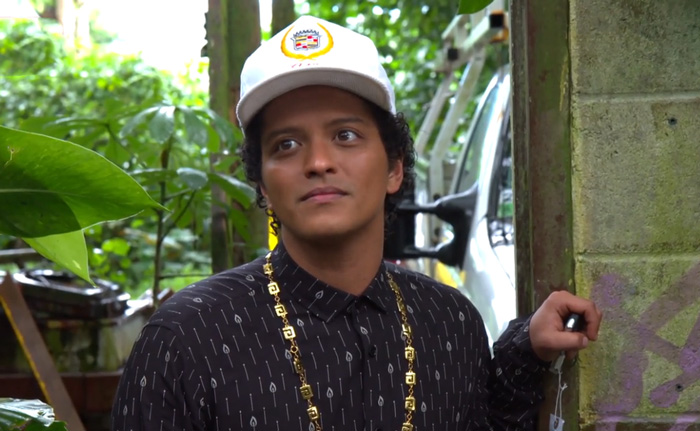On a humid afternoon in Honolulu, Hawaii, in early July 2025, global superstar Bruno Mars stood outside the crumbling frame of a one-room shack in the overgrown ruins of Paradise Park, a former bird zoo. The structure, once a temporary home for Mars, his father Peter Hernandez, and brother Eric after his parents’ divorce, had no bathroom, no running water, and barely a roof. Yet, as Mars gazed at the dilapidated site, his voice softened with nostalgia: “We had it all. We had each other.” This poignant moment, captured in a forthcoming documentary segment teased by CBS News, offered a rare glimpse into the humble beginnings of the Grammy-winning artist, whose journey from poverty to pop icon status is defined by an unshakable family bond and a love for music. Drawing on recent interviews and Mars’ reflections, this article explores the significance of his return, the hardships that shaped him, and the enduring legacy of his Hawaiian roots.
The Shack: A Symbol of Hardship and Heart
Bruno Mars, born Peter Gene Hernandez on October 8, 1985, in Honolulu, grew up in a vibrant, musical family. His father, Pete “Dr. Doo-Wop” Hernandez, a Puerto Rican percussionist from Brooklyn, and mother, Bernadette San Pedro Bayot, a Filipina singer and hula dancer, ran a Las Vegas-style revue called The Love Notes at the Sheraton Waikiki Hotel. From age two, Mars joined the act as “Little Elvis,” earning local fame for his impersonations of Elvis Presley and Michael Jackson, as noted in a 1990 MidWeek feature. The family’s home was filled with instruments, jukeboxes, and a karaoke machine, fostering a creative environment for Mars and his five siblings—Jaime, Tiara, Tahiti, Presley, and Eric. “Everybody in my family sings, plays instruments. It’s what we do,” Mars told Hawaii’s MidWeek in 2010.
But when Mars was 12, his parents’ divorce ended The Love Notes and their financial stability. Peter, Eric, and Bruno faced dire circumstances, living in a car, on rooftops, and eventually in the one-room shack at Paradise Park, where Peter worked briefly before the zoo closed. In a 2016 60 Minutes interview, Mars recalled the shack: “It didn’t have plants growing inside. It had a roof… We’d all sleep in one bed.” Despite the lack of amenities, including a bathroom that required a trek across the park, Mars described these years as “the best,” emphasizing the family’s unity: “We had each other, and it never felt like it was the end of the world.” His return in 2025, filmed for a documentary, was his first time back since childhood, a moment he shared with CBS News correspondent Lara Logan, pointing to where their bed once stood in the now-roofless structure.
A Family Forged in Music
The Hernandez family’s resilience was rooted in music and love. Peter, who grew up immersed in doo-wop and Latin orchestras, formed The Love Notes, which was inducted into the Doo-Wop Hall of Fame in 2014, per the Boston Globe. Bernadette, who moved to Hawaii from Manila in 1968, was the lead hula dancer in Al Harrington’s show before joining Peter’s act. Their children inherited this passion, with Bruno performing five nights a week by age four, as detailed in Wikipedia. His siblings also pursued creative paths: Eric became Mars’ drummer in the Hooligans and Silk Sonic, while sisters Jaime, Tiara, Tahiti, and Presley formed The Lylas, a pop group featured on a 2013 WE tv reality show.
Mars credits this environment for his fearless stage presence. “Performing from such a young age just got me so comfortable on stage,” he told MidWeek in 2010. His early gigs, including a cameo as Little Elvis in Honeymoon in Vegas (1992), shaped his retro showmanship, blending rock, reggae, R&B, and doo-wop influences from his parents’ 1950s-inspired act. Peter told MidWeek in 2014, “Bruno is the product of a lot of love from all his family,” highlighting the supportive dynamic that carried them through poverty. Mars’ childhood, though marked by hardship, was rich with creativity, as he learned to play piano, guitar, and drums without formal training, surrounded by his family’s music.
The Emotional Return: Reflecting on Roots
Mars’ 2025 visit to the shack, teased in a CBS News clip, was a deeply personal moment. Now 39, with 15 Grammy Awards, eight Billboard Hot 100 No. 1 singles, and recent hits like “Die With a Smile” with Lady Gaga, Mars stood in stark contrast to the boy who once slept in that single bed. Yet his humility shone through as he reflected, “We had it all. We had each other.” The documentary, set to air later in 2025, captures Mars walking through the overgrown site, now a jungle-like ruin, and sharing memories with his father and brother. “It’s OK we don’t have electric today, we’re gonna figure it out,” he recalled thinking, a mindset that fueled his relentless work ethic.
The visit came at a pivotal moment in Mars’ career. Following his 2024 successes, including topping Spotify’s global streaming charts and breaking records with “APT.” alongside BLACKPINK’s Rosé, Mars is preparing a new album and tour in 2025, per Las Vegas Magazine. His return to Hawaii was not just nostalgic but a reaffirmation of the values that drive him. In a 2017 60 Minutes interview, he said, “I was built for this… dedicating yourself to your craft,” a dedication rooted in those early years of struggle. The shack, though dilapidated, symbolized the resilience that propelled him from Honolulu to Hollywood.

A Mother’s Influence and Lasting Grief
The visit also stirred memories of Mars’ mother, Bernadette, who died suddenly of a brain aneurysm in 2013 at 55. In a 2017 Latina interview, Mars shared the depth of his loss: “She’s more than my music. If I could trade music to have her back, I would.” Bernadette’s influence was profound; she bought him a piano at age two, where he played “actual tunes,” not just noise, as she told Inquirer Lifestyle. Her death, just as Mars bought her a house in Hawaii, left a void. “She’d call me every day to tell me how much fun she’s having,” he told Rolling Stone, describing the heartbreak of losing her.
During the documentary visit, Mars spoke of his mother’s role in keeping the family together, her voice harmonizing their home. Peter echoed this in MidWeek, saying, “No woman could ever love Bruno as much as his late mother did.” The shack, where Mars lived with his father and brother post-divorce, contrasted with the warmth of his mother’s presence, making his return bittersweet. Fans on X noted the emotional weight, with posts like “Bruno standing in that shack, talking about his family, hits different. That’s real love.”
Public and Media Reaction
The teaser clip of Mars’ visit, shared on CBS News’s social media, went viral, amassing over 2 million views by July 15, 2025. Fans flooded X with reactions: “Bruno’s humility is everything. From a shack to stadiums,” and “That ‘we had each other’ line broke me.” Media outlets praised the moment’s authenticity. The List called it “a testament to Mars’ down-to-earth nature,” while Billboard noted, “His story of resilience resonates with anyone who’s faced hardship.” Some skeptics on Reddit questioned the documentary’s timing, suggesting it was a promotional move for his 2025 album, but most saw it as genuine, aligning with Mars’ history of honoring his roots, like his $100,000 donation to typhoon-affected children in the Philippines in 2014.
The visit paralleled other 2025 tributes, like Johnny Depp and Alice Cooper’s performance of “Paranoid” for Ozzy Osbourne, reflecting a trend of artists reconnecting with their past. Mars’ story, however, stood out for its intimacy, offering a counterpoint to his glamorous image. Vulture praised his ability to “make the personal universal,” citing his 2024 hit “Die With a Smile” as evidence of his emotional depth.
Broader Significance: Resilience and Legacy
Mars’ return to the shack underscores the power of family and music in overcoming adversity. His childhood, marked by poverty yet rich with love, shaped his genre-hopping style, blending doo-wop, reggae, R&B, and pop. “Growing up in Hawaii made me the man I am,” he told Wikipedia in 2010, crediting the island’s diverse musical culture. His 2025 projects, including a cover of Elvis’ “Burning Love” for Lilo & Stitch by his nephews Nyjah Music and Zyah Rhythm, continue this family tradition.
The shack also symbolizes Mars’ authenticity in an industry often criticized for artifice. His 2013 ballad “When I Was Your Man,” inspired by personal heartbreak, and his 2024 collaboration with Rosé show his ability to channel raw emotion into universal hits. As The New York Times noted, Mars’ music “delights the shit out of us,” rooted in the “groove” he learned from his father’s doo-wop and his mother’s soulful melodies. His visit challenges narratives of overnight success, showing how hardship forged his work ethic and humility.
Conclusion
Bruno Mars’ return to the one-room shack in Paradise Park in July 2025 was more than a nostalgic pilgrimage; it was a testament to the family bond and musical passion that carried him from poverty to global stardom. Standing amidst the ruins, his words—“We had it all. We had each other”—captured a truth that resonates beyond his Hawaiian roots. From performing as Little Elvis to topping charts with “Uptown Funk” and “Die With a Smile,” Mars’ journey reflects resilience, love, and an unwavering commitment to his craft. As he prepares for a new album and tour in 2025, this emotional moment, shared with millions, reminds us that behind the glitz lies a heart shaped by music and family, forever grounded in the shack where it all began.



